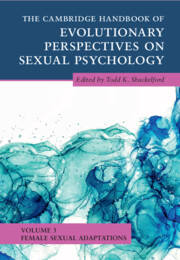Book contents
- The Cambridge Handbook of Evolutionary Perspectives on Sexual Psychology
- The Cambridge Handbook of Evolutionary Perspectives on Sexual Psychology
- Copyright page
- Contents
- Contributors
- Preface
- Part I Precopulatory Adaptations
- 1 Women’s Preferences: Precopulatory Adaptations
- 2 Female Sexual Attraction Tactics
- 3 Extra-Pair Sexual Interest
- 4 Female Intrasexual Competition
- 5 Female Intersexual Selection
- 6 Evolution of Precopulatory Defense from Rape and Coercion in Women
- 7 Mate Poaching
- Part II Copulatory Adaptations
- Part III Postcopulatory Adaptations
- Index
- References
7 - Mate Poaching
from Part I - Precopulatory Adaptations
Published online by Cambridge University Press: 30 June 2022
- The Cambridge Handbook of Evolutionary Perspectives on Sexual Psychology
- The Cambridge Handbook of Evolutionary Perspectives on Sexual Psychology
- Copyright page
- Contents
- Contributors
- Preface
- Part I Precopulatory Adaptations
- 1 Women’s Preferences: Precopulatory Adaptations
- 2 Female Sexual Attraction Tactics
- 3 Extra-Pair Sexual Interest
- 4 Female Intrasexual Competition
- 5 Female Intersexual Selection
- 6 Evolution of Precopulatory Defense from Rape and Coercion in Women
- 7 Mate Poaching
- Part II Copulatory Adaptations
- Part III Postcopulatory Adaptations
- Index
- References
Summary
Mate poaching is a form of romantic attraction in humans defined as a “behavior intended to attract someone who is already in a romantic relationship” (Schmitt & Buss, 2001; p. 894). Two essential criteria to mate poaching are that a romantic relationship from which a poached individual comes is monogamous, and that a poacher is aware that the relationship he/she is poaching from is exclusive. Mate poaching is a reasonably common practice to form new short-term and long-term romantic relationships. In most world regions, women report less frequent poaching attempts for short-term and long-term relationships than men do. Additionally, higher proportions of women report poaching attempts for a long-term than for a short-term relationship, whereas almost equal proportions of men report poaching attempts for long-term and short-term relationships. Women are less frequently successfully poached than men for both short-term and long-term relationships, but more women succumb to long-term than short-term poaching attempts. Research on sex differences shows that some environmental factors moderate women’s short-term mate poaching. Women are more inclined to short-term mate poaching in resource-rich environments, in societies with higher levels of gender equality and in those where women outnumber men. A number of other biological, psychological, and social factors affect women’s mate poaching experiences such as phase of their menstrual cycle, the level of commitment to their romantic partners, mate value of their current partners and poachers, previous friendship with poachers, mate-guarding and infidelity detection, enticement and disguising tactics, mate copying, and personality characteristics. The relationships between mate poaching experiences and personality characteristics are small to moderate, the largest between mate poaching and the Dark triad traits, followed by several of the Sexy Seven dimensions, five-factor personality traits, sociosexuality, and attachment styles. As a poacher or a poached, women may be exposed to various costs such as jealousy, violent acts from their partner ranging from subtle violence to rape and uxoricide, feelings of shame, and social exclusion. Their new relationships may be characterized by lower satisfaction and commitment, higher jealousy and infidelity, and their children may suffer lower investment and physical abuse from a stepfather. As victims of poaching, women may experience a loss of a high-quality partner and his resources. One of the main benefits of women’s mate poaching can be derived from the dual mating hypothesis. It states that by simultaneous pursuing of short-term and long-term mating strategies women may obtain investment from a regular partner and superior genes from an affair partner. Growing evidence suggests that one function of women’s mate poaching is breaking up with one partner and remating with another, known as the mate switching hypothesis. Other possible benefits of women’s mate poaching are taking pride in the conquest of a long-term relationship, taking revenge on a rival, gaining an already proven mate, obscuring paternity, and increasing genetic variability of offspring.
- Type
- Chapter
- Information
- Publisher: Cambridge University PressPrint publication year: 2022
References
- 1
- Cited by

